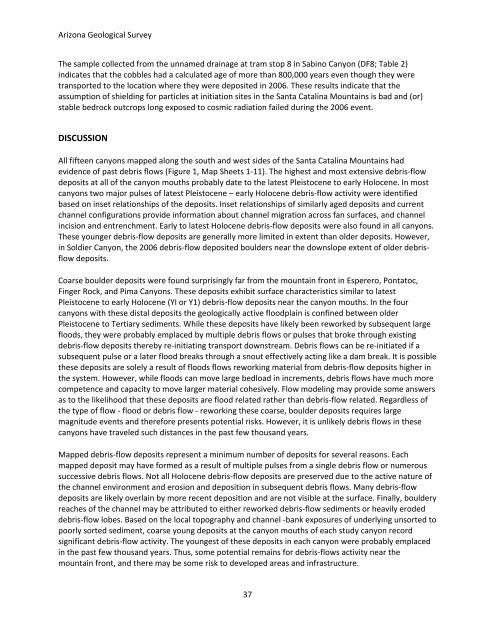Arizona Geological Survey OPEN-FILE REPORT OFR 08-06
Arizona Geological Survey OPEN-FILE REPORT OFR 08-06
Arizona Geological Survey OPEN-FILE REPORT OFR 08-06
Create successful ePaper yourself
Turn your PDF publications into a flip-book with our unique Google optimized e-Paper software.
<strong>Arizona</strong> <strong>Geological</strong> <strong>Survey</strong><br />
The sample collected from the unnamed drainage at tram stop 8 in Sabino Canyon (DF8; Table 2)<br />
indicates that the cobbles had a calculated age of more than 800,000 years even though they were<br />
transported to the location where they were deposited in 20<strong>06</strong>. These results indicate that the<br />
assumption of shielding for particles at initiation sites in the Santa Catalina Mountains is bad and (or)<br />
stable bedrock outcrops long exposed to cosmic radiation failed during the 20<strong>06</strong> event.<br />
DISCUSSION<br />
All fifteen canyons mapped along the south and west sides of the Santa Catalina Mountains had<br />
evidence of past debris flows (Figure 1, Map Sheets 1‐11). The highest and most extensive debris‐flow<br />
deposits at all of the canyon mouths probably date to the latest Pleistocene to early Holocene. In most<br />
canyons two major pulses of latest Pleistocene – early Holocene debris‐flow activity were identified<br />
based on inset relationships of the deposits. Inset relationships of similarly aged deposits and current<br />
channel configurations provide information about channel migration across fan surfaces, and channel<br />
incision and entrenchment. Early to latest Holocene debris‐flow deposits were also found in all canyons.<br />
These younger debris‐flow deposits are generally more limited in extent than older deposits. However,<br />
in Soldier Canyon, the 20<strong>06</strong> debris‐flow deposited boulders near the downslope extent of older debrisflow<br />
deposits.<br />
Coarse boulder deposits were found surprisingly far from the mountain front in Esperero, Pontatoc,<br />
Finger Rock, and Pima Canyons. These deposits exhibit surface characteristics similar to latest<br />
Pleistocene to early Holocene (YI or Y1) debris‐flow deposits near the canyon mouths. In the four<br />
canyons with these distal deposits the geologically active floodplain is confined between older<br />
Pleistocene to Tertiary sediments. While these deposits have likely been reworked by subsequent large<br />
floods, they were probably emplaced by multiple debris flows or pulses that broke through existing<br />
debris‐flow deposits thereby re‐initiating transport downstream. Debris flows can be re‐initiated if a<br />
subsequent pulse or a later flood breaks through a snout effectively acting like a dam break. It is possible<br />
these deposits are solely a result of floods flows reworking material from debris‐flow deposits higher in<br />
the system. However, while floods can move large bedload in increments, debris flows have much more<br />
competence and capacity to move larger material cohesively. Flow modeling may provide some answers<br />
as to the likelihood that these deposits are flood related rather than debris‐flow related. Regardless of<br />
the type of flow ‐ flood or debris flow ‐ reworking these coarse, boulder deposits requires large<br />
magnitude events and therefore presents potential risks. However, it is unlikely debris flows in these<br />
canyons have traveled such distances in the past few thousand years.<br />
Mapped debris‐flow deposits represent a minimum number of deposits for several reasons. Each<br />
mapped deposit may have formed as a result of multiple pulses from a single debris flow or numerous<br />
successive debris flows. Not all Holocene debris‐flow deposits are preserved due to the active nature of<br />
the channel environment and erosion and deposition in subsequent debris flows. Many debris‐flow<br />
deposits are likely overlain by more recent deposition and are not visible at the surface. Finally, bouldery<br />
reaches of the channel may be attributed to either reworked debris‐flow sediments or heavily eroded<br />
debris‐flow lobes. Based on the local topography and channel ‐bank exposures of underlying unsorted to<br />
poorly sorted sediment, coarse young deposits at the canyon mouths of each study canyon record<br />
significant debris‐flow activity. The youngest of these deposits in each canyon were probably emplaced<br />
in the past few thousand years. Thus, some potential remains for debris‐flows activity near the<br />
mountain front, and there may be some risk to developed areas and infrastructure.<br />
37
















